Polish people
Polacy (Polish) | |||||||||||||||||||||||||||||||||||||||||||||||||||||||||||||||||||
|---|---|---|---|---|---|---|---|---|---|---|---|---|---|---|---|---|---|---|---|---|---|---|---|---|---|---|---|---|---|---|---|---|---|---|---|---|---|---|---|---|---|---|---|---|---|---|---|---|---|---|---|---|---|---|---|---|---|---|---|---|---|---|---|---|---|---|---|
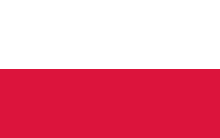 The flag of Poland, one of the symbols of Polish people | |||||||||||||||||||||||||||||||||||||||||||||||||||||||||||||||||||
| Total population | |||||||||||||||||||||||||||||||||||||||||||||||||||||||||||||||||||
| c. 60 million[1] | |||||||||||||||||||||||||||||||||||||||||||||||||||||||||||||||||||
| Regions with significant populations | |||||||||||||||||||||||||||||||||||||||||||||||||||||||||||||||||||
 | |||||||||||||||||||||||||||||||||||||||||||||||||||||||||||||||||||
| United States | 10,600,000 (2015)[1][3][4] | ||||||||||||||||||||||||||||||||||||||||||||||||||||||||||||||||||
| Germany | 2,253,000 (2018)[5] | ||||||||||||||||||||||||||||||||||||||||||||||||||||||||||||||||||
| Brazil | 1,800,000 (2007)[6] | ||||||||||||||||||||||||||||||||||||||||||||||||||||||||||||||||||
| Canada | 1,010,705 (2013)[7] | ||||||||||||||||||||||||||||||||||||||||||||||||||||||||||||||||||
| France | 1,000,000 (2022)[8][9][10] | ||||||||||||||||||||||||||||||||||||||||||||||||||||||||||||||||||
| United Kingdom | 682,000 (2021)[11][12] | ||||||||||||||||||||||||||||||||||||||||||||||||||||||||||||||||||
| |||||||||||||||||||||||||||||||||||||||||||||||||||||||||||||||||||
| Languages | |||||||||||||||||||||||||||||||||||||||||||||||||||||||||||||||||||
| |||||||||||||||||||||||||||||||||||||||||||||||||||||||||||||||||||
| Religion | |||||||||||||||||||||||||||||||||||||||||||||||||||||||||||||||||||
| Predominantly Roman Catholicism[36] | |||||||||||||||||||||||||||||||||||||||||||||||||||||||||||||||||||
| Related ethnic groups | |||||||||||||||||||||||||||||||||||||||||||||||||||||||||||||||||||
| Other West Slavs Especially other Lechites | |||||||||||||||||||||||||||||||||||||||||||||||||||||||||||||||||||
Polish people, or Poles,
The population of self-declared Poles in Poland is estimated at 37,394,000 out of an overall population of 38,512,000 (based on the 2011 census),[40] of whom 36,522,000 declared Polish alone.[2][41][4] A wide-ranging Polish diaspora (the Polonia) exists throughout Eurasia, the Americas, and Australasia. Today, the largest urban concentrations of Poles are within the Warsaw metropolitan area and the Katowice urban area.
Ethnic Poles are considered to be the descendants of the ancient West Slavic
Exonyms
The Polish
Among other foreign
Ethnogenesis
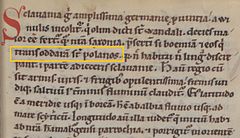
Slavs have been in the territory of modern-day Poland for over 1500 years.[47] During the Migration Period, central Europe was becoming increasingly settled by the early Slavs (500–700 AD).[47] They organized into tribal units, of which the larger ones further west were later known as the Polish tribes (Lechites);[48] the names of many tribes are found on the list compiled by the anonymous Bavarian Geographer in the 9th century.[49] In the 9th and 10th centuries the tribes gave rise to developed regions along the upper Vistula (the Vistulans),[49] the Baltic Sea coast and in Greater Poland. The ultimate tribal undertaking (10th century) resulted in a lasting political structure and the creation of a Polish state.[50]
Language
Polish-speakers use the language in a uniform manner throughout most of Poland, though numerous
The geographical distribution of the
Culture
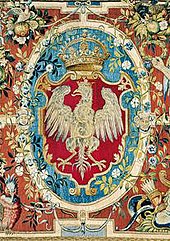
The culture of Poland is closely connected with its intricate 1,000-year
Officially, the national and state symbol is the white-tailed eagle (bielik) embedded on the Coat of arms of Poland (godło).[58] The national colours are white and red, which appropriately appear on the flag of Poland (flaga), banners, cockades and memorabilia.[58]
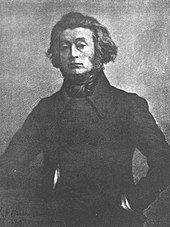
Personal achievement and education plays an important role in Polish society today. In 2018, the
Poland's
According to a 2020 study, Poland ranks 12th globally on a list of countries which read the most, and approximately 79% of Poles read the news more than once a day, placing it 2nd behind Sweden.[63] As of 2021, six Poles received the Nobel Prize in Literature.[b] The national epic is Pan Tadeusz (English: Master Thaddeus), written by Adam Mickiewicz. Renowned novelists who gained much recognition abroad include Joseph Conrad (wrote in English; Heart of Darkness, Lord Jim), Stanisław Lem (science-fiction; Solaris) and Andrzej Sapkowski (fantasy; The Witcher).
Various regions in Poland such as Greater Poland, Lesser Poland, Mazovia, Silesia, and Pomerania developed their own distinct cultures, cuisines, folk costumes and dialects. Also, Poland for centuries was a refuge to many Jews and to Armenians, who became an important part of Polish society and similarly developed their own unique cultures.
Popular everyday foods in Poland include pork cutlets (
Religion
Poles have traditionally adhered to the Christian faith; an overwhelming majority belongs to the
There are smaller communities primarily comprising
Religious organizations in the Republic of Poland can register their institution with the
Geographic distribution
This section needs additional citations for verification. (September 2021) |
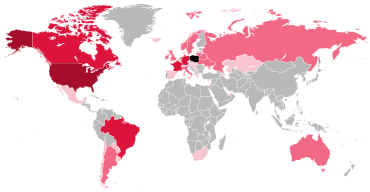
Polish people are the sixth-largest national group in the European Union (EU).[71] Estimates vary depending on source, though available data suggest a total number of around 60 million people worldwide (with roughly 18-20 million living outside of Poland, many of whom are not of Polish descent, but are Polish nationals).[72] There are almost 38 million Poles in Poland alone. There are also strong Polish communities in neighbouring countries, whose territories were once occupied or part of Poland – Czech Republic, Slovakia, Lithuania, Latvia, western Ukraine, and western Belarus.
The term "
In the United States, a significant number of Polish immigrants settled in
See also
- Demographics of Poland
- Karta Polaka
- Lechites
- List of Poles
- Names of Poland (etymology of the demonym)
- Pole and Hungarian brothers be
- Poles in France
- Poles in Germany
- Poles in Latvia
- Poles in Lithuania
- Poles in Norway
- Poles in Romania
- Poles in the Soviet Union
- Poles in Spain
- Poles in the United Kingdom
- Polish Americans
- Polish Argentines
- Polish Australians
- Polish Brazilians
- Polish Canadians
- Polish Chileans
- Polish Mexicans
- Polish minority in Ireland
- Polish Czechs
- Polish nationality law
- Polish New Zealanders
- Polish Uruguayans
- Polish Venezuelans
- Polonization
- Sons of Poland
- West Slavs
Notes
- ^ Polish: Polacy, pronounced [pɔˈlat͡sɨ]; singular masculine: Polak, singular feminine: Polka
- ^ In some instances only five laureates are acknowledged as Isaac Bashevis Singer resided in the United States and primarily wrote in Yiddish.
References
- ^ a b 37.5–38 million in Poland and 21–22 million ethnic Poles or people of ethnic Polish extraction elsewhere. "Polmap. Rozmieszczenie ludności pochodzenia polskiego (w mln)" Archived 30 July 2015 at the Wayback Machine
- ^ ISBN 978-83-7027-597-6. Archived(PDF) from the original on 8 August 2019. Retrieved 8 February 2018.
- ^ "Stowarzyszenie Wspólnota Polska". Wspolnota-polska.org.pl. Archived from the original on 24 October 2013. Retrieved 21 August 2017.
- ^ a b Główny Urząd Statystyczny (January 2013). Ludność. Stan i struktura demograficzno-społeczna [Narodowy Spis Powszechny Ludności i Mieszkań 2011] (PDF) (in Polish). Główny Urząd Statystyczny. pp. 89–101. Archived (PDF) from the original on 6 July 2019. Retrieved 12 December 2014.
- ^ Bevölkerung mit Migrationshintergrund - Ergebnisse des Mikrozensus - Fachserie 1 Reihe 2.2 - 2018 Archived 7 August 2020 at the Wayback Machine, page 62, retrieved 29 November 2019.
- ^ a b c d e f g h Polska Diaspora na świecie, Stowarzyszenie Wspólnota Polska, 2007. Retrieved 14 August 2020.
- ^ "Ethnic Origin (264), Single and Multiple Ethnic Origin Responses (3), Generation Status (4), Age Groups (10) and Sex (3) for the Population in Private Households of Canada, Provinces, Territories, Census Metropolitan Areas and Census Agglomerations, 2011 National Household Survey". 8 May 2013. Archived from the original on 24 December 2018. Retrieved 24 November 2013.
- ^ Erwin Dopf. "Présentation de la Pologne". diplomatie.gouv.fr. Archived from the original on 14 December 2023. Retrieved 1 July 2022.
- ^ "Présentation de la Pologne". Archived from the original on 22 January 2021. Retrieved 24 January 2021.
- ^ "Europe: where do people live?". Archived from the original on 9 June 2016. Retrieved 27 July 2020.
- ^ "Population of the United Kingdom by country of birth and nationality, July 2020 to June 2021". ons.gov.uk. Office for National Statistics. Archived from the original on 3 January 2024. Retrieved 5 February 2023..
- ^ "Polish workers abandon brexit Britain in favour of Germany:Aljazeera.com". Archived from the original on 21 November 2019. Retrieved 31 July 2020.
- ^ "Clarín.com – La ampliación de la Unión Europea habilita a 600 mil argentinos para ser comunitarios". Edant.clarin.com. 27 April 2004. Archived from the original on 3 March 2016. Retrieved 14 November 2014.
- ^ "Archived copy" (PDF). www.belstat.gov.by. Archived from the original (PDF) on 9 July 2021. Retrieved 30 June 2022.
{{cite web}}: CS1 maint: archived copy as title (link) - ^ a b c Wspólnota Polska. "Stowarzyszenie Wspólnota Polska". Wspolnota-polska.org.pl. Archived from the original on 24 October 2013. Retrieved 14 November 2014.
- ^ "Australian Bureau of Statistics, Australian Government". Archived from the original on 15 July 2020. Retrieved 7 November 2021.
- ^ "Jews, by Country of Origin and Age". Statistical Abstract of Israel (in English and Hebrew). Israel Central Bureau of Statistics. 26 September 2011. Archived from the original on 5 January 2019. Retrieved 11 February 2012.
- ^ "2021 censusm". 16 December 2015. Archived from the original on 16 February 2008. Retrieved 6 January 2022.
- ^ "Ukrainian Census 2001". 2001.ukrcensus.gov.ua. Archived from the original on 2 December 2013. Retrieved 14 November 2014.
- ^ "Polacy przestali kochać Irlandię. Myślą o powrocie". 17 October 2018. Archived from the original on 6 August 2020. Retrieved 10 February 2020.
- ^ "Immigrants and Norwegian-born to immigrant parents". 9 March 2020. Archived from the original on 11 April 2016. Retrieved 21 February 2020.
- ^ "Maleje liczba Polaków we Włoszech" [The number of Poles in Italy is decreasing]. Naszswiat.net (in Polish). Archived from the original on 3 November 2016. Retrieved 1 January 2016.
- ^ "Befolkning efter födelseland och ursprungsland 31 december 2012" (in Swedish). Statistics Sweden. 31 December 2013. Archived from the original on 24 September 2015. Retrieved 22 December 2013.
- ^ http://www.statistik.at/web_de/statistiken/menschen_und_gesellschaft//bevoelkerung_am_1.1.2015_nach_detailliertem_geburtsland_und_bundesland-2.pdf [dead link]
- ^ a b c "Immigrant and Emigrant Populations by Country of Origin and Destination". 10 February 2014. Archived from the original on 28 March 2020. Retrieved 28 March 2020.
- ^ "On key provisional results of Population and Housing Census 2011". Csb.gov.lv. Archived from the original on 6 July 2018. Retrieved 14 November 2014.
- ^ "Statistics Denmark:FOLK1: Population at the first day of the quarter by sex, age, ancestry, country of origin and citizenship". Statistics Denmark. Archived from the original on 29 November 2019. Retrieved 26 September 2014.
- ^ "Kazakhstan National Census 2009". Stat.kz. Archived from the original on 18 November 2018.
- ^ Wspólnota Polska. "Stowarzyszenie Wspólnota Polska". Wspolnota-polska.org.pl. Archived from the original on 10 August 2018. Retrieved 14 November 2014.
- ^ "Population by country of birth, sex and age 1 January 1998-2022". Statistics Iceland. 2022. Archived from the original on 27 September 2023. Retrieved 31 August 2023.
- ^ "Foreigners by category of residence, sex, and citizenship as at 31 December 2016". Archived from the original on 12 January 2018. Retrieved 11 October 2017.
- ISBN 978-963-235-542-9. Archived (PDF) from the original on 8 August 2019. Retrieved 9 January 2019.)
{{cite book}}:|work=ignored (help)CS1 maint: location missing publisher (link - ^ "Ante la crisis, Europa y el mundo miran a Latinoamérica" (in Spanish). Acercando Naciones. 2012. Archived from the original on 18 May 2015.
- ^ "SODB2021 - Obyvatelia - Základné výsledky". www.scitanie.sk. Archived from the original on 15 July 2022. Retrieved 25 August 2022.
- ^ "Sefstat2022" (PDF).
- ^ )
- ^ Historya ksia̜ża̜t i królów polskich krótko zebrana – Teodor Waga – Google Books. J. Zawadzki. 9 July 2020. Archived from the original on 27 September 2023. Retrieved 19 March 2023.
- ^ Historya krolow i ksiazat polskich krotko zebrana dla lepszego uzytku Wyd ... – Theodor Waga – Google Books. Zupanski. 9 July 2020. Archived from the original on 27 September 2023. Retrieved 19 March 2023.
- ^ Gerard Labuda. Fragmenty dziejów Słowiańszczyzny zachodniej, t. 1–2 s.72 2002; Henryk Łowmiański. Początki Polski: z dziejów Słowian w I tysiącleciu n.e., t. 5 s.472; Stanisław Henryk Badeni, 1923. s. 270.
- Central Statistical Office (January 2013). "The national-ethnic affiliation in the population – The results of the census of population and housing in 2011" (PDF) (in Polish). p. 1. Archived(PDF) from the original on 15 May 2020. Retrieved 6 March 2013.
- ISBN 978-83-7027-597-6. Archived(PDF) from the original on 8 August 2019. Retrieved 8 February 2018.
- ^ Gerard Labuda. Fragmenty dziejów Słowiańszczyzny zachodniej, t.1–2 p.72 2002; Henryk Łowmiański. Początki Polski: z dziejów Słowian w I tysiącleciu n.e., t. 5 p.472; Stanisław Henryk Badeni, 1923. p. 270.
- ^ Gliński, Mikołaj (6 December 2016). "The Many Different Names of Poland". Culture.pl. Archived from the original on 31 March 2019. Retrieved 31 March 2019.
- ^ Lehr-Spławiński, Tadeusz (1978). Język polski. Pochodzenie, powstanie, rozwój. Warszawa (Warsaw): Państwowe Wydawnictwo Naukowe. p. 64.
- ISBN 978-83-7063-411-7. Archivedfrom the original on 4 April 2023. Retrieved 19 March 2023.
- ISBN 978-83-65746-64-1.
- ^ a b Zbigniew Kobyliński. "The Slavs" Archived 22 May 2022 at the Wayback Machine. The New Cambridge Medieval History, pp. 530–537
- ^ Zenon Klemensiewicz: Historia języka polskiego t.III. Warszawa: PWN, 1985. P. 418-471. ISBN 83-01-06443-9.
- ^ ISBN 978-0-19-925339-5.
- ^ Marek Derwich; Adam Żurek (2002). U źródeł Polski (do roku 1038) (in Polish). pp. 122–143.
- ^ "Język polski". Towarzystwo Miłośników Języka Polskiego. 27 July 2000. Archived from the original on 27 September 2023. Retrieved 29 September 2021 – via Google Books.
- ISBN 978-83-7052-347-3. Archivedfrom the original on 27 September 2023. Retrieved 29 September 2021 – via Google Books.
- ^ "Which Languages Are Spoken in Poland?". WorldAtlas. 18 July 2018. Archived from the original on 23 December 2021. Retrieved 29 September 2021.
- ISBN 978-83-7383-143-8.
- ^ "Acta Cassubiana. Vol. XVII (map on p. 122)". Instytut Kaszubski. 2015. Archived from the original on 10 February 2018. Retrieved 9 February 2018.
- ^ "Kaschuben heute: Kultur-Sprache-Identität" (PDF) (in German). 2007. Archived from the original (PDF) on 3 January 2016. Retrieved 3 January 2016.
- ISBN 0-7818-0200-8
- ^ a b (in Polish) Konstytucja Rzeczypospolitej Polskiej Archived 1 June 2019 at the Wayback Machine [(in English) Constitution of the Republic of Poland Archived 15 May 2019 at the Wayback Machine], Dz.U. 1997 nr 78 poz. 483
- ^ "PISA 2018 results". oecd.org. OECD. 2018. Archived from the original on 3 December 2019. Retrieved 29 September 2021.
- ISBN 978-1-5275-0740-1.
- ISBN 978-83-7271-768-9. Archived from the originalon 3 March 2016. Retrieved 3 May 2018.
- ISBN 978-0-520-24525-9.
- ^ Cabrera, Isabel (2020). "World Reading Habits in 2020 [Infographic]". geediting.com. Global English Editing. Archived from the original on 4 May 2022. Retrieved 29 September 2021.
- ^ Eurostat (2019). "Overweight and obesity - BMI statistics". ec.europa.eu. European Union. Archived from the original on 8 January 2023. Retrieved 30 September 2021.
- ^ Food and Agriculture Organization of the United Nations (FAO) (2017). "Food balances data 2017". FAO.org. Archived from the original on 11 May 2017. Retrieved 21 October 2021.
- ^ "WHO Global status report on alcohol and health 2018" (PDF). who.int. Archived (PDF) from the original on 10 February 2021.
- ^ "Europe: Poland — the World Factbook - Central Intelligence Agency". The World Factbook. Archived from the original on 8 January 2023. Retrieved 14 November 2014.
- ISBN 978-83-7027-521-1Retrieved 27 December 2014.
- ^ (in Polish) Kościoły i związki wyznaniowe w Polsce Archived 5 August 2009 at the Wayback Machine. Retrieved 17 June 2008.
- ^ Scott Simpson, Native Faith: Polish Neo-Paganism at the Brink of the 21st Century, 2000.
- ^ NationMaster.com 2003–2008. People Statistics: Population (most recent) by country Archived 3 June 2009 at the Wayback Machine. Retrieved 25 January 2008.
- ^ "Record number of Poles in Britain: statistics office" (in Polish). association "Polish Community". Archived from the original on 17 May 2019. Retrieved 21 November 2013.
- ^ ""Sueddeutsche Zeitung": Polska przeżywa największą falę emigracji od 100 lat". Wiadomosci.onet.pl. 26 September 2014. Archived from the original on 8 March 2021. Retrieved 20 August 2017.
- ^ "Polish - CSO - Central Statistics Office". www.cso.ie. Archived from the original on 18 September 2018. Retrieved 2 May 2022.

